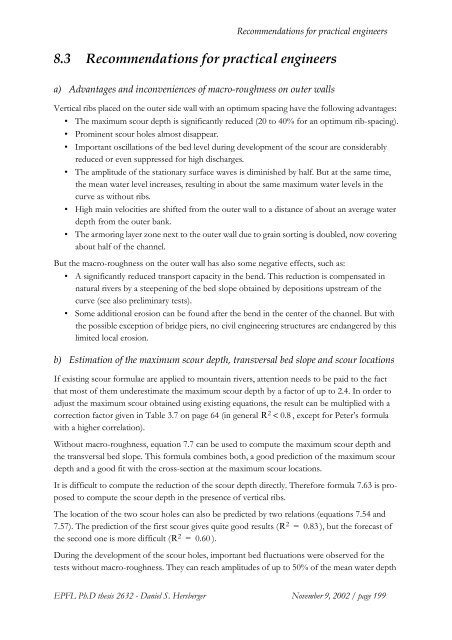pdf, 12 MiB - Infoscience - EPFL
pdf, 12 MiB - Infoscience - EPFL
pdf, 12 MiB - Infoscience - EPFL
Create successful ePaper yourself
Turn your PDF publications into a flip-book with our unique Google optimized e-Paper software.
Recommendations for practical engineers<br />
8.3 Recommendations for practical engineers<br />
a) Advantages and inconveniences of macro-roughness on outer walls<br />
Vertical ribs placed on the outer side wall with an optimum spacing have the following advantages:<br />
• The maximum scour depth is significantly reduced (20 to 40% for an optimum rib-spacing).<br />
• Prominent scour holes almost disappear.<br />
• Important oscillations of the bed level during development of the scour are considerably<br />
reduced or even suppressed for high discharges.<br />
• The amplitude of the stationary surface waves is diminished by half. But at the same time,<br />
the mean water level increases, resulting in about the same maximum water levels in the<br />
curve as without ribs.<br />
• High main velocities are shifted from the outer wall to a distance of about an average water<br />
depth from the outer bank.<br />
• The armoring layer zone next to the outer wall due to grain sorting is doubled, now covering<br />
about half of the channel.<br />
But the macro-roughness on the outer wall has also some negative effects, such as:<br />
• A significantly reduced transport capacity in the bend. This reduction is compensated in<br />
natural rivers by a steepening of the bed slope obtained by depositions upstream of the<br />
curve (see also preliminary tests).<br />
• Some additional erosion can be found after the bend in the center of the channel. But with<br />
the possible exception of bridge piers, no civil engineering structures are endangered by this<br />
limited local erosion.<br />
b) Estimation of the maximum scour depth, transversal bed slope and scour locations<br />
If existing scour formulae are applied to mountain rivers, attention needs to be paid to the fact<br />
that most of them underestimate the maximum scour depth by a factor of up to 2.4. In order to<br />
adjust the maximum scour obtained using existing equations, the result can be multiplied with a<br />
correction factor given in Table 3.7 on page 64 (in general R 2 < 0.8 , except for Peter’s formula<br />
with a higher correlation).<br />
Without macro-roughness, equation 7.7 can be used to compute the maximum scour depth and<br />
the transversal bed slope. This formula combines both, a good prediction of the maximum scour<br />
depth and a good fit with the cross-section at the maximum scour locations.<br />
It is difficult to compute the reduction of the scour depth directly. Therefore formula 7.63 is proposed<br />
to compute the scour depth in the presence of vertical ribs.<br />
The location of the two scour holes can also be predicted by two relations (equations 7.54 and<br />
7.57). The prediction of the first scour gives quite good results ( R 2 = 0.83 ), but the forecast of<br />
the second one is more difficult ( R 2 = 0.60 ).<br />
During the development of the scour holes, important bed fluctuations were observed for the<br />
tests without macro-roughness. They can reach amplitudes of up to 50% of the mean water depth<br />
<strong>EPFL</strong> Ph.D thesis 2632 - Daniel S. Hersberger November 9, 2002 / page 199
















